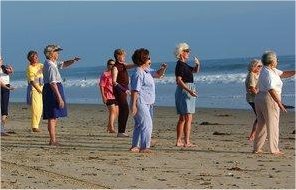
Exercising To Stay Healthy For Better Retirement
Recent studies assert that exercise improves quality of life and longevity in seniors -- one report found that exercising in old age helps prevent dementia, for instance. But that doesn't give you permission to put off fitness until your AARP card arrives. There are plenty of benefits for middle-agers: cardiovascular health helps prevent heart disease; strong muscles ease daily chores (and enhance recreation); agility and balance guard against falls and injuries. Oh yeah, fitness helps you look and feel better, too.
If you're already exercising regularly, use that impressive flexibility to pat yourself on the back. But if you're not -- that is, if you are among the "deconditioned," to use the proper term -- it's time to start. Remember: Exercise can improve the health and vitality of an octogenarian. View anything you begin now as a head start.
If you're a pure neophyte or (it's okay, you can admit it) it's been so long that your workout clothes don't fit, start with simple walking. Set a goal of 30 minutes at moderate intensity -- that is, at a pace that's challenging but still allows you to carry on a conversation. Do this as often as possible, even if that's only three days a week for now. Or two. Any's better than none when you're starting out.
If walking bores you, consider cycling, swimming or other low-impact activity that gets your heart rate elevated. (Any cardio machine at the gym will do the trick, too.) "Start at five or 10 minutes and work up to 30 minutes," said Michael E. Rogers, research director of the Center for Physical Activity and Aging at Wichita State University in Wichita, Kan., and chairman of the American College of Sports Medicine's healthy aging group. "Cardio-respiratory fitness is one of the most important controllable risk factors in death and chronic disease."
If you walk or otherwise move briskly for 30 minutes four or five times a week, you'll reap many health benefits of exercise: In addition to reduced disease risk, you may enjoy better sleep, relief of some joint and back pain and improved chances of controlling your weight.
Once you're comfortable with the cardio routine, add some strength training, balance and stretching. Those weight machines at the gym are okay, but it's better to use dumbbells. (Choose a weight you can lift about 15 times before your muscle tires.) Dumbbells require you to guide the weight through space, and they draw on the multiple muscles required to lift, reach, turn and otherwise move in the real world. Machines just isolate single muscles and build them up.
You can also work major muscle groups with body-weight exercises, such as push-ups, pull-ups, squats and crunches (the updated form of sit-ups).
A great publication for beginning exercise is the ACSM Fitness Book (184 pages; $16.95; www.acsm.org/publications/books.htm#fitness).
Gradually boost workout intensity and length as your body allows. If you overdo it in a burst of newbie enthusiasm, you'll get sore and frustrated and -- like legions before you -- quit.
Shoot for 45 minutes of exercise four days a week; 60 minutes on five days is better still. Remember, your midlife body may take a couple of days to recover from harder or longer sessions, so alternate your days of cardio workouts with strength and balance training. Reserve at least one day weekly for recreational exercise (gardening, hiking, golf, tennis, canoeing, etc.).
Stretching is crucial: "After men achieve their peak range of motion in their mid-twenties and women in their late twenties, flexibility declines significantly," Rogers noted. The ACSM book has excellent recommendations for beginning stretches. But whatever you stretch, do not bounce! Just trust us on that.
And then? Each week the Moving Crew provides more ideas for developing, fine-tuning and (hey, it could happen) turbocharging your fitness program through midlife and beyond.
By John Briley
http://www.washingtonpost.com/
